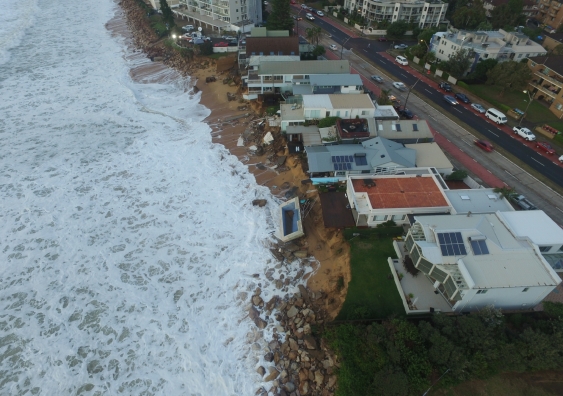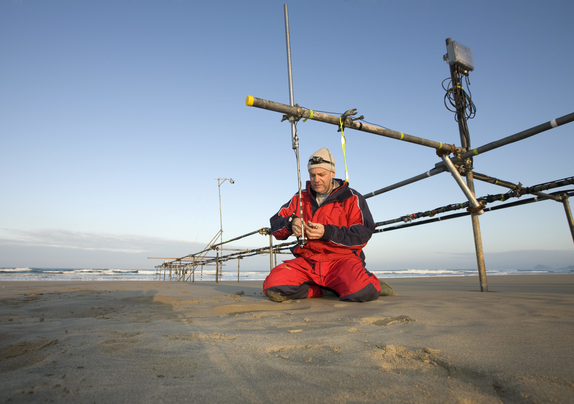The world-first coastal hazard system reduces the risks associated with Australian coastal storms.
A new framework for a (EWS) developed by UNSW engineers can forecast the beach erosion and flooding impacts of storms approaching Australiaās sandy coastlines.
The coastal hazard system predicts the severity of impacts every 100 metres alongshore and at identified āhotspotsā ā considered vulnerable or housing valuable infrastructure ā in near real time. It delivers rolling seven-day forecasts to local and regional coastal managers and emergency response agencies through a web portal.
The engineers detailed their system in a research paper published today in the international journal .
Changing storm patterns are emerging with climate change, affecting beachfront areas in diverse ways, says lead researcher Professor Ian Turner from UNSWās (WRL). Coastal hazards associated with significant weather events can extend over large regions yet vary greatly in local impact.
An EWS can provide the localised predictions coastal managers need to better prepare for emergencies and protect vulnerable coastal communities and property, he says.
Media enquiries
For enquiries about this story and to arrange interviews, please contact Lachlan Gilbert.
Tel: +61 2 9065 5241
·”³¾²¹¾±±ō:Ģżlachlan.gilbert@unsw.edu.au
āCoastal storms pose a threat to livelihoods and assets along Australiaās coastlines: not just homes and buildings but roads, power and water utility corridors [and] sewerage lines,ā says the coastal specialist.
āOur forecasting system enables us to anticipate the impacts of coming storms. It can tell us at a local level, will the beach become narrower or is it going to erode or indeed is it going to flood?ā
; . Approximately 50 per cent of Australians live within seven kilometres of the coast. The great majority of our urban and industrial infrastructure is located in coastal settings, where sandy beaches experience relatively high wave energy.
Weāre accustomed to checking weather apps for hazardous heat, rain, wind, even surf, says Prof. Turner. āBut while we've seen some pretty dramatic impacts of storms on the coast, to our knowledge, national forecasting agencies around the world don't have the capability to send out a coastal erosion warning when a storm is approaching.ā
Coastal setting significantly influences storm hazards. While most existing coastal hazard EWSs forecast flooding risks, Australiaās narrow continental shelf means beach erosion poses a greater risk.
New storm hazard matrix better informs our emergency response
The framework for national-scale coastal storm hazards early warning was developed in partnership with the Australian Bureau of Meteorology (BoM), NSW Department of Planning and Environment, WA Department of Transport, Northern Beaches Council, City of Mandurah, United States Geological Survey, the University of Western Australia (UWA) and UNSW Sydney. The research was funded by an Australian Research Council (ARC) linkage grant.
The EWS has been piloted in two geographically distinct regions since mid 2023 to facilitate future wide-scale deployment: on the east (Pacific Ocean) coast, ~450 km around Sydney, characterised by quartz sandy beaches; and on the west (Indian and Southern Oceans) coast, ~350 km around Perth characterised by a mix of sand beaches and limestone nearshore reefs.Ā
Hazards are categorised using a new Storm Hazard Matrix to help coastal managers identify appropriate management responses. The matrix considers the compound severity of their erosion (from minor beach narrowing to dune retreat) and flooding hazards.Ā
It draws on data from government partners on sea-floor mapping, nearshore waves and water-levels, and beach and dune features. The BoM also developed an experimental high-resolution wave modelling system that delivers seven-day wave forecasts for this project.
To evaluate the systemās accuracy, the research team has hindcast past storm events, such as the 2016 āsuperstormā. The storm affected a 2000 km stretch of Australiaās east coast from Tasmania to the Queensland border, eroding 11.5 million cubic metres of sand, flooding towns and damaging infrastructure.
āAlong many of the impacted beaches ā for example Collaroy-Narrabeen here in Sydney ā some areas of the beach experienced very dramatic damage and erosion, while nearby at the same beach the changes were much less dramatic,ā Prof. Turner says.Ā
āUsing our measurements of the changes that occurred along the NSW coastline in June 2016, we can retrospectively see how well we would have done in that storm and yes, we would have put a big red flag, where in fact, we memorably saw that swimming pool lying on the beach and homes being evacuated.ā
Beach erosion a bigger threat due to Australiaās narrow continental shelf
Coastal setting significantly influences storm hazards, Prof. Turner says. āWhile most existing coastal hazard EWSs forecast flooding risks, Australiaās narrow continental shelf means beach erosion poses a greater risk,ā he says.Ā
Flooding predominantly occurs along coastlines dominated by storm surges (powerful ocean movements caused by wind and low pressure on the oceanās surface).Ā
āIn much of North America and large areas of Europe, the continental shelf is much wider, so most of the wave energy tends to dissipate before it gets to the coastline, but the water level gets higher.āĀ
However, the more densely populated and developed areas of Australian coastline ā to the southeast and southwest ā are less affected by storm surges, he says. āIt's actually wave energy [from storms] hitting the coast that impacts and erodes our beaches and damages coastal infrastructure.ā
Flooding is an issue for some West Australian coastal zones, says Associate Professor Jeff Hansen from UWA. āIn WA, travelling south from the Perth metro area, the primary hazard transitions from erosion to inundation in Geographe Bay where the coastal profile is wide and shallow,ā he says.Ā
Australia is a large continent with a really diverse coastline, Prof. Turner says. āBy delivering timely information about approaching coastal storms, the new forecasting system we have developed with our partners can improve community preparedness and risk-reduction measures, to help reduce potential impacts to property, critical infrastructure and loss of life.ā
The pilot Australian Beach Erosion and Coastal Flooding EWS can be viewed through the .








